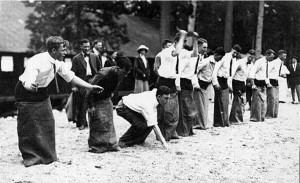 This guest post comes from Ariela Rozman, chief executive officer of The New Teacher Project, an entrepreneurial organization that is changing the conversation about teacher effectiveness across the country.
This guest post comes from Ariela Rozman, chief executive officer of The New Teacher Project, an entrepreneurial organization that is changing the conversation about teacher effectiveness across the country.
Discussion of the Obama administration’s Race to the Top competition often resembles coverage of a major political campaign. Most of the focus is on the horse race—who’s winning and who’s losing. But more important than the handicapping is the long-term reform that this modestly-sized program has brought to traditionally paralyzed state governments. Indeed, the $4.3 billion in Race to the Top grants is almost certain to spur more significant improvements in our schools than the rest of the $49 billion in proposed federal K-12 education funding this year, or the other $95 billion in federal stimulus funding for education last year.
Consider what Race to the Top has already accomplished, before a single dollar from the program has been spent: sixteen states have enacted far-reaching legislative or regulatory reforms that will make a difference for generations of students— reforms like lifting charter school caps that have stifled innovation, or developing better teacher evaluation systems that will help schools build stronger instructional teams and give them the support they need to do their best work. And states like Colorado and Maryland have proposed more legislative changes as they ramp up for round two of the competition.
In the first round of awards, Race to the Top proved to be a tremendously well-structured and focused program. The administration established rigorous guidelines and stressed repeatedly that they would reward innovation and bold thinking. It followed through on that promise by selecting just two states–Tennessee and Delaware–as the competition’s first winners: both states submitted strong applications that, taken together, set a high bar for states to meet or exceed in round two.
That’s not to say that everything has gone perfectly. To be effective and sustainable, competitive funding programs that involve public dollars must have well-executed scoring processes that identify the winners fairly, consistently and credibly. Unfortunately, it’s also where the administration came up a bit short in round one, as we discussed in a report earlier this month. We found evidence of frequent score inflation, of reviewers deviating from scoring guidelines, and of particularly lax or harsh reviewers having an excessive impact on a state’s final score.
Fortunately, the administration can easily fix these problems by taking simple steps to improve the review process such as ensuring that scoring guidance is more robust, improving the selection and training of reviewers, and implementing basic quality control measures to ensure fairness and consistency in the scores. The administration must make these changes before it scores the round two applications, and it should apply the lessons it learns to future competitive grant programs. So long as it does, Race to the Top is likely to live up to its promise.
It’s not hard to see the influence of education entrepreneurs on Race to the Top, which in many ways represents an acknowledgement of their impact over the last two decades. A host of organizations—including some within the NewSchools community and many others across the country—have fought to put our schools on a different path by bringing new ideas and models to the field. We took chances and failed; and we took still more chances and have shown the beginnings of success.
What united us was not that we had all the answers but that we shared a core conviction: creating better schools can be done. This is the same belief and the same spirit that Race to the Top now seeks to instill in states nationwide; it encourages them to think big and escape the failures of the past.
To education entrepreneurs, this represents a compliment but also a challenge—a chance to go beyond boutique programs and pilot projects and implement at scale. It is important to remember that, for years, we asked only for the opportunity to prove the promise of our ideas. We may now get it. The question is whether we are truly ready for it. If we are not, we will be the dog that caught the car.
One key to making the most of the new landscape is preparing for accountability in a new way. As outsiders, we have used accountability to argue for change: “The status quo is unacceptable,” we said, “so you should allow us to experiment.” But we must begin to accept that outsiders are increasingly becoming insiders. We will be held accountable for doing better than the old status quo; if we do not, our experiments will have been proven failures.
This is a healthy development for our movement. We can take some pointers from the Obama administration and the Race to the Top competition itself. The old measures of organizational success—demonstrating potential, attracting funding, earning modest research validation—are no longer enough. The challenge for all of us now, individually and collectively, is to seize this opportunity to transform our schools and show that we deserved the chance to do so. We can only do that by delivering on the promises we have made for so long. The race is on, and it’s ours to lose.
Ariela Rozman is CEO of The New Teacher Project (TNTP). She joined the organization in 2001, leading marketing, strategy, and the Teaching Fellows Programs before becoming CEO in 2007. Before joining TNTP, Ariela worked in the private sector at PlanetRx.com, Muresco, and Bain & Co. She also sits on the board of The Mind Trust and is an advisor to Teach Plus.